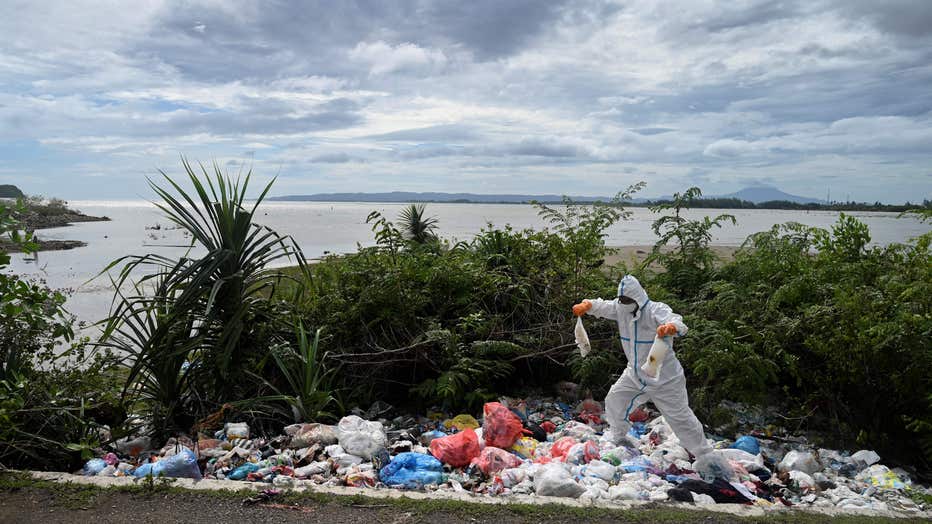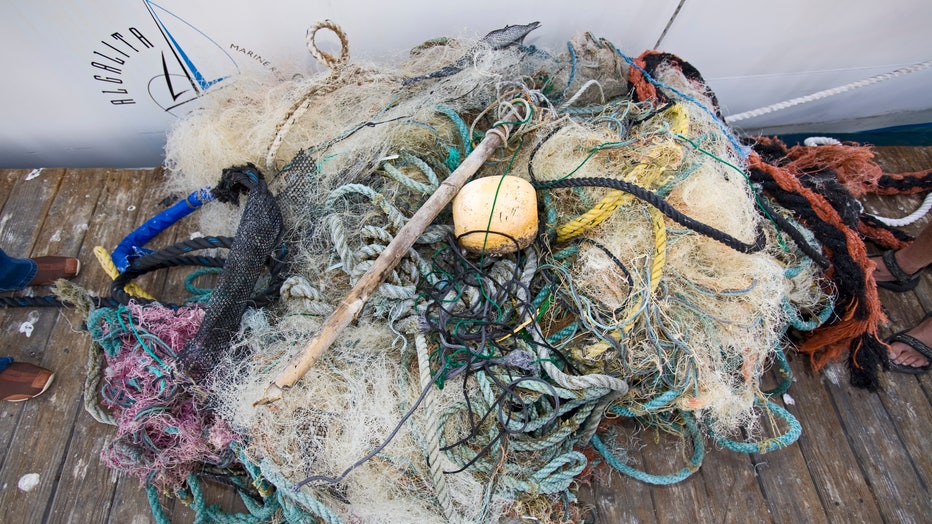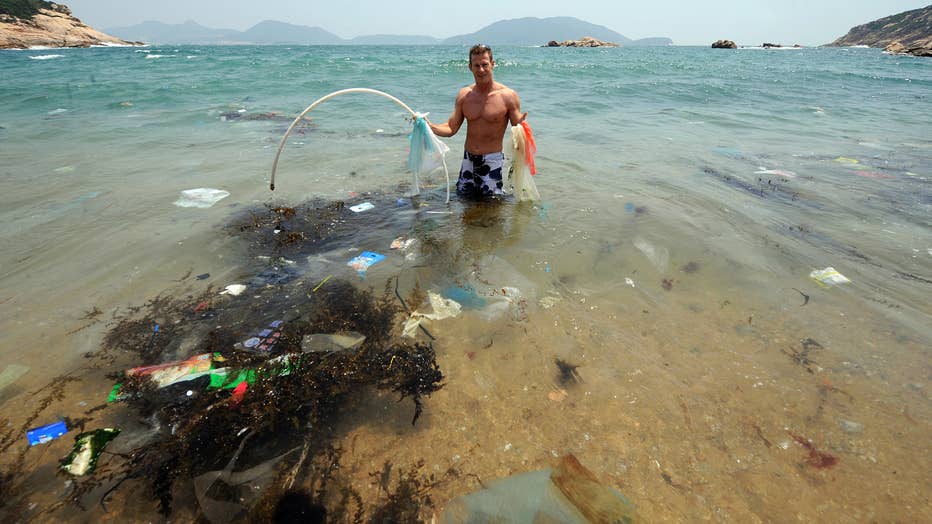170 trillion pieces of plastic are in the Earth’s oceans, study finds

The oceans have a massive plastic pollution problem
How do you quantify 170 trillion pieces of plastic in the Earth's oceans? Two researchers who were part of a major plastic pollution study sat down with FOX TV Stations to explain.
Imagine the weight of a million midsize SUVs lined up from Maine to California. Now picture that much plastic spread across the Earth’s oceans.
Roughly 170 trillion pieces of plastic are in our oceans, a new major study concludes, and most of them are too small to see with the naked eye. Researchers say in the past 18 years, the amount of plastic entering the oceans has soared.
The study, done by a team of global researchers led by Marcus Eriksen of the 5 Gyres Institute, looked at 40 years of data from 11,600 points in the ocean. They also sailed the world to see it for themselves.
From 1979 through 2004 or 2005, "things were pretty steady," Eriksen told FOX TV Stations.
"But from 2005 onward, we see a skyrocketing abundance of microplastic," he said.
What are microplastics?
Microplastics are created when man-made materials break down into tiny particles smaller than about 5 millimeters (roughly one-fifth of an inch). One plastic bag, for example, can turn into 10,000 microplastics.

A volunteer checks plastic waste while conducting research on the amount of micro-plastics contained in the water at a beach in Pekan Bada, Indonesia's Aceh province on June 2, 2022. (Photo by CHAIDEER MAHYUDDIN/AFP via Getty Images)
Some pieces can be seen with the naked eye, but most of them require a microscope, said Lisa Erdle, director of science and innovation for the 5 Gyres Institute, a California nonprofit that studies plastic pollution and how to reduce it in our oceans.
Microplastics come from a variety of sources, Erdle said, like single-use bottles and containers, car tires that shed rubber on roadways and even microfibers from a load of laundry.
"A single load of laundry can emit up to 18 million microfibers," Erdle said.
READ MORE: Infants ingest 15 times more microplastics than adults, new study finds
The largest concentrations of plastic pollution in the oceans are found near population centers, but there are five accumulation zones – or gyres – where ocean wind currents create garbage patches.
One of those gyres, the Great Pacific Garbage Patch, was twice the size of Texas in 2018.
How did that much plastic get into the ocean?
Eriksen said the unfathomable amount of plastic in our oceans can be attributed to three things.

Trash and assorted garbage collected form the North Pacific Gyre. (Photo by: Citizen of the Planet/Education Images/Universal Images Group via Getty Images)
First, the trash already out there is falling apart, fragmenting into smaller and smaller pieces.
Plastic production has also drastically increased since 2005. More than 5 million tons of new plastics have been made in the last 18 years, "and more plastic means, unfortunately, more pollution."
When researchers at 5 Gyres conduct pollution surveys for cities, they find single-use plastics and cigarette butts at the top of most lists.
READ MORE: Evidence of PFAS, ‘forever chemicals,’ found in toilet paper, study says
"But the next are your usual suspects in most cities: straws, bags, bottle caps, bottles themselves, utensils, these are some of the biggest polluters," Eriksen said.
Another factor in the pollution problem is a lack of international maritime laws that regulate illegal dumping of plastic, Eriksen said. In the 1970s and ‘80s, the agreements countries had in place were "legally binding, and they worked."
"Since the millennium, international treaties have been voluntary, and by and large they all fail," he said.
Why is this a big deal?

A volunteer checks plastic waste while conducting research on the amount of micro-plastics contained in the water at a beach in Pekan Bada, Indonesia's Aceh province on June 2, 2022. (Photo by CHAIDEER MAHYUDDIN/AFP via Getty Images)
The study, published in the PLOS One journal, "is really just the tip of the iceberg," Erdle said.
"We find these microplastic particles from the deepest parts of the ocean to remote mountain peaks, and these particles are getting into us," Erdle said. "We’re breathing it in. We’re drinking it in our water … eating microplastics in our foods. We’re literally eating and drinking our trash."
A 2019 report from the World Health Organization said the levels of microplastics in drinking water don’t appear to be risky, but also cautioned that research had been spotty and more was needed. The report said they do cause harm to smaller organisms and wildlife
In a 2021 study, researchers found that high levels of microplastics in the human body may be harmful to cells. Microplastics were found in human blood for the first time last year.
"We know enough about the negative effects to try to keep it from getting in the environment in the first place, because these particles are so small they’re not easily cleaned up," Erdle said. "Once they’re in the environment, it’s almost too late."
What’s the solution?
If the world could somehow stop adding more trash to the Earth’s oceans, they would likely just take care of themselves, Eriksen said.
"The ocean is perhaps the best mechanism for cleaning up itself," Eriksen said. "If we were to stop adding more … I think you would see the ocean within 10 years, would export, would kick out all the trash in it."
So how do we stop the trash from getting there in the first place?

Conservationist displays rubbish on May 07, 2009 on a beach on the south side of Hong Kong which has been left uncleaned. (Photo credit should read MIKE CLARKE/AFP via Getty Images)
Eriksen and Erdle said it’s critical that cities take inventory on which kinds of plastic pollution are entering their streams and rivers, then take action – capturing trash on the streets, using compostable materials to replace plastic straws and containers, and seeking more "alternative ways to serve society without the legacy of waste," Eriksen said.
Eriksen also hopes that countries will bring back legally binding international treaties to reduce the amount of plastic being dumped into the oceans.
"Let’s focus on preventative measures, less on cleanup and recycling, more on prevention," Eriksen said. "We think that’s the best way to stop this problem."

